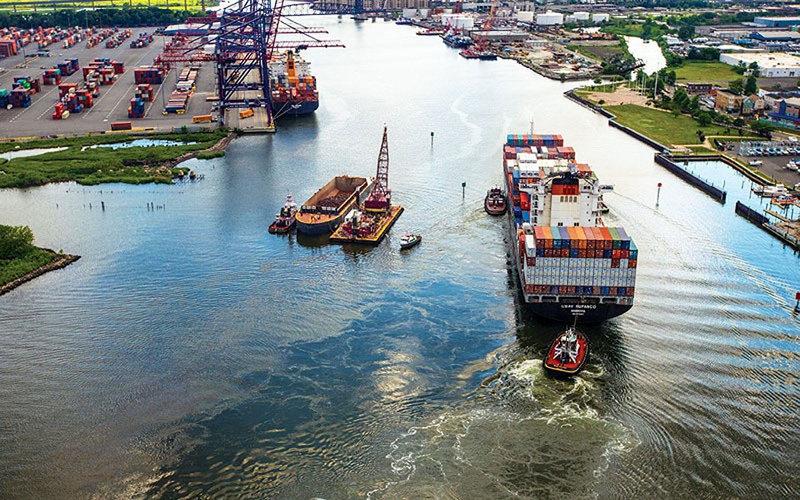After more than 20 years of dredging and blasting, port officials and the U.S. Army Corps of Engineers marked the official completion of the Main Navigation Channel Deepening Program in New York and New Jersey.
Initiated in 1989, the $2.1 billion mega-project anticipated by nearly 30 years the expansion of the Panama Canal and the bigger cargo vessels it would bring to U.S. ports.
It also changed the way the Corps and U.S. Environmental Protection Agency deal with contaminated sediment from harbors. The prospect of business as usual – dumping dredge spoils at sea, tainted with decades of industrial pollution – triggered an uproar from the fishing and tourism industries and environmental groups that delayed deepening for years in the 1990s.
New strategies were developed – processing sediment to reduce contamination, using it to cap landfills and cleaner sediments to restore wetlands around the harbor. Bedrock blasted and raised from the bottom of the Kill Van Kull channel between Staten Island, N.Y., and Bayonne, N.J., went to build artificial fishing reefs off the New Jersey beaches.
“We were able to solve a significant environmental problem by thinking outside the box. It wasn’t perfect. It’s still a work in progress. But the overall result was truly a win-win," said Cynthia Zipf, executive director of an environmental group, Clean Ocean Action, that challenged early ocean disposal plans in court.
In all, 38 miles of federal channels were dredged to as deep as 50’. The final tally for public and private investment to prepare the New Jersey and New York ports for 21st century shipping totaled some $6 billion. While dredging has been declared complete, other projects are still underway, like the $1.3 billion job of raising the Bayonne Bridge over the Kill Van Kull to accommodate the air draft of neo-Panamax containerships.
With 23 million consumers in its affluent urban and suburban region, New York/New Jersey is the largest port on the East Coast and the nation’s third-busiest in cargo moved. At a Sept. 1 event at the Global Marine Terminal in Bayonne, Molly Campbell, director of the port department for the Port Authority of New York and New Jersey, said the 27-year effort toward deepening “will continue to support the 336,000 jobs and billions in economic activity the port generates.”
"We, the Army Corps, are so proud of this accomplishment. We worked closely with the Port Authority, DOT, other Administration partners, and state and local partners to get this ‘We Can't Wait’ infrastructure project done,” said Jo-Ellen Darcy, Assistant Secretary of the Army for Civil Works.
Col. David Caldwell, the Army Corps’ New York district commander, called it “the most important and influential project related to modern day economics in the Northeast.”
The port remained opened during all phases of construction, Caldwell said, and the project was executed in a manner that saved over $800 million while using the dredged material for environmental projects. He credited “the dedication and hard work or the New York District, Port Authority and a host of partners and stakeholders.”
But it took five years of often bitter debate to reach that consensus. The maritime industry and ocean dumping critics in particular started off seeing each other as deadly threats.
“It was a very contentious time. EPA proposed expanding the Mud Dump site,” the traditional offshore disposal area, already known to be polluted, Zipf recalled.
Industry and labor saw the potential for channels to shoal while environmental issues were fought in court. Longshoremen packed public hearings to warn of dire job losses if big ships could not get into Port Newark and Port Elizabeth.
But in time, public agencies, stakeholders and the region’s Congressional delegation helped craft compromises. In 1995 the federal agencies with primary responsibility for the port – the EPA, Department of Transportation, and Department of Defense – signed an agreement to better manage dredged material, effectively using the navigation project as a means to clean up decades of contamination at the bottom of the harbor.
“We need to evolve,” Zipf said. “Dumping in the ocean is not what we do anymore.”





